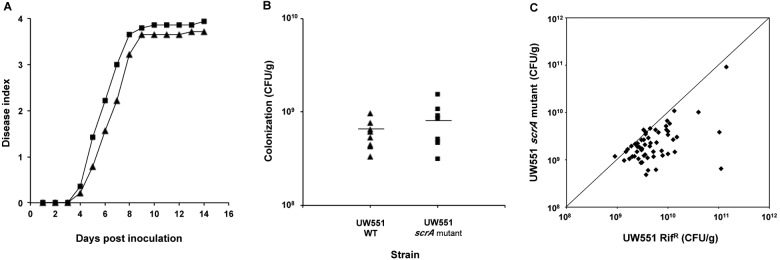FIG 5 .
Sucrose metabolism provides R. solanacearum with a competitive advantage during xylem colonization. (A to C) Twenty-two-day-old wilt-resistant H7996 tomato plants were inoculated through a cut petiole with 4 µl of wild-type R. solanacearum UW551 (WT) or UW551 scrA::Kmr (UW551 scrA) (A and B) or with a 1:1 mixture of wild-type R. solanacearum UW551 Rifr and scrA mutant (~2,000 CFU total) (C). (A) Wilt disease progress of wild-type UW551 and scrA mutant strains on stem-inoculated tomato plants that were rated as described in the legend to Fig. 4. (B) Stem colonization ability of wild-type UW551 and scrA mutant cells stem inoculated separately on tomato plants. Ten plants displaying a disease index of 1 (corresponding to 5 days after inoculation) were sampled per treatment (UW551 WT or UW551 scrA mutant), and the bacterial population sizes in the stems were quantified by dilution plating. Each symbol represents one plant; short horizontal lines represent the mean bacterial colonization in tomato stems. (C) Competitive fitness of wild-type and scrA mutant strains. The tomato plants were sampled 5 days postinoculation, and in planta population sizes of wild-type and scrA mutant strains were quantified by dilution plating. Data represent two biological replicates containing 30 plants each. The WT strain significantly outcompeted the scrA mutant in planta (P < 0.006 by paired Student’s t test).

